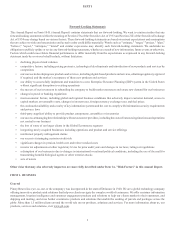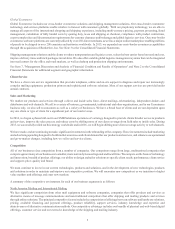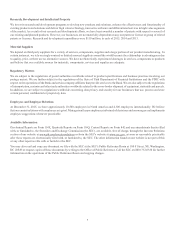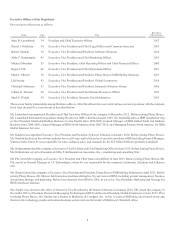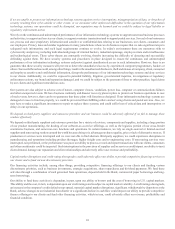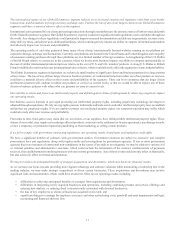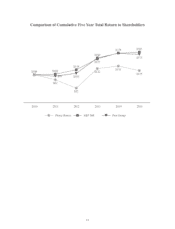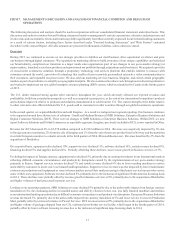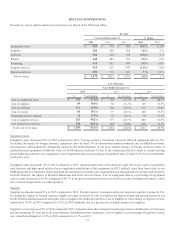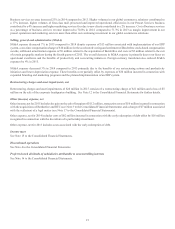Pitney Bowes 2015 Annual Report Download - page 27
Download and view the complete annual report
Please find page 27 of the 2015 Pitney Bowes annual report below. You can navigate through the pages in the report by either clicking on the pages listed below, or by using the keyword search tool below to find specific information within the annual report.
11
The international nature of our Global Ecommerce segment subjects us to increased customs and regulatory risks from cross-border
transactions, and fluctuations in foreign currency exchange rates. Further, the loss of any of our largest clients in our Global Ecommerce
segment could have a material adverse effect on the segment.
International sales generated by our clients processing transactions through our platform are the primary source of both revenue and profit
for the Global Ecommerce segment. Our Global Ecommerce segment is subject to significant trade regulations, taxes, and duties throughout
the world. Any changes to these regulations could potentially impose increased documentation and delivery requirements, increase costs,
delay delivery times, and subject us to additional liabilities, which could negatively impact our ability to compete in international markets
and adversely impact our revenues and profitability.
The operating results of, and sales generated from, many of our clients’ internationally focused websites running on our platform are
exposed to foreign exchange rate fluctuations. Currently, our platforms are located in the United States and United Kingdom and a majority
of consumers making purchases through these platforms are in a limited number of foreign countries. A strengthening of the U.S. Dollar
or British Pound relative to currencies in the countries where we do the most business impacts our ability to compete internationally as
the cost of similar international products improves relative to the cost of U.S. and U.K. retailers' products. A strong U.S. Dollar or British
Pound would likely result in a decrease in international sales volumes, which would adversely affect the segment's revenue and profitability.
The Global Ecommerce segment is dependent on a relatively small number of significant clients and business partners for a large portion
of its revenue. The loss of any of these larger clients or business partners, or a substantial reduction in their use of our products or services,
could have a material adverse effect on the revenue and profitability of the segment. There can be no assurance that our larger clients
and business partners will continue to utilize our products or services at current levels, or that we would be able to replace any of these
clients or business partners with others who can generate revenue at current levels.
Our inability to obtain and protect our intellectual property and defend against claims of infringement by others may negatively impact
our operating results.
Our business success depends in part upon protecting our intellectual property rights, including proprietary technology developed or
obtained through acquisitions. We rely on copyrights, patents, trademarks and trade secrets and other intellectual property laws to establish
and protect our proprietary rights. If we are unable to protect our intellectual property rights, our competitive position may suffer which
could adversely affect our revenue and profitability.
From time to time, third-parties may claim that we, our clients, or our suppliers, have infringed their intellectual property rights. These
claims, if successful, may require us to redesign affected products, enter into costly settlement or license agreements, pay damage awards,
or face a temporary or permanent injunction prohibiting us from marketing or selling certain products.
If we fail to comply with government contracting regulations, our operating results, brand name and reputation could suffer.
We have a significant number of contracts with governmental entities. Government contracts are subject to extensive and complex
procurement laws and regulations, along with regular audits and investigations by government agencies. If one or more government
agencies discovers instances of contractual non-compliance in the course of an audit or investigation, we may be subject to various civil
or criminal penalties and administrative sanctions, which could include the termination of the contract, reimbursement of payments
received, fines and debarment from doing business with one or more governments. Any of these events could not only affect us financially,
but also adversely affect our brand and reputation.
We may not realize the anticipated benefits of strategic acquisitions and divestitures, which may harm our financial results.
As we increase our focus towards providing more digital technology and software solutions while maintaining a leadership role in the
mailing industry, we may make strategic acquisitions or divest certain businesses. These acquisitions and divestitures may involve
significant risks and uncertainties, which could have an adverse effect on our operating results, including:
• difficulties in achieving anticipated benefits or synergies from acquisitions and divestitures;
• difficulties in integrating newly acquired businesses and operations, including combining product and service offerings and
entering new markets, or reducing fixed costs previously associated with divested businesses;
• the loss of key employees or clients of businesses acquired or divested; and
• significant charges to earnings for employee severance and other restructuring costs, goodwill and asset impairments and legal,
accounting and financial advisory fees.




